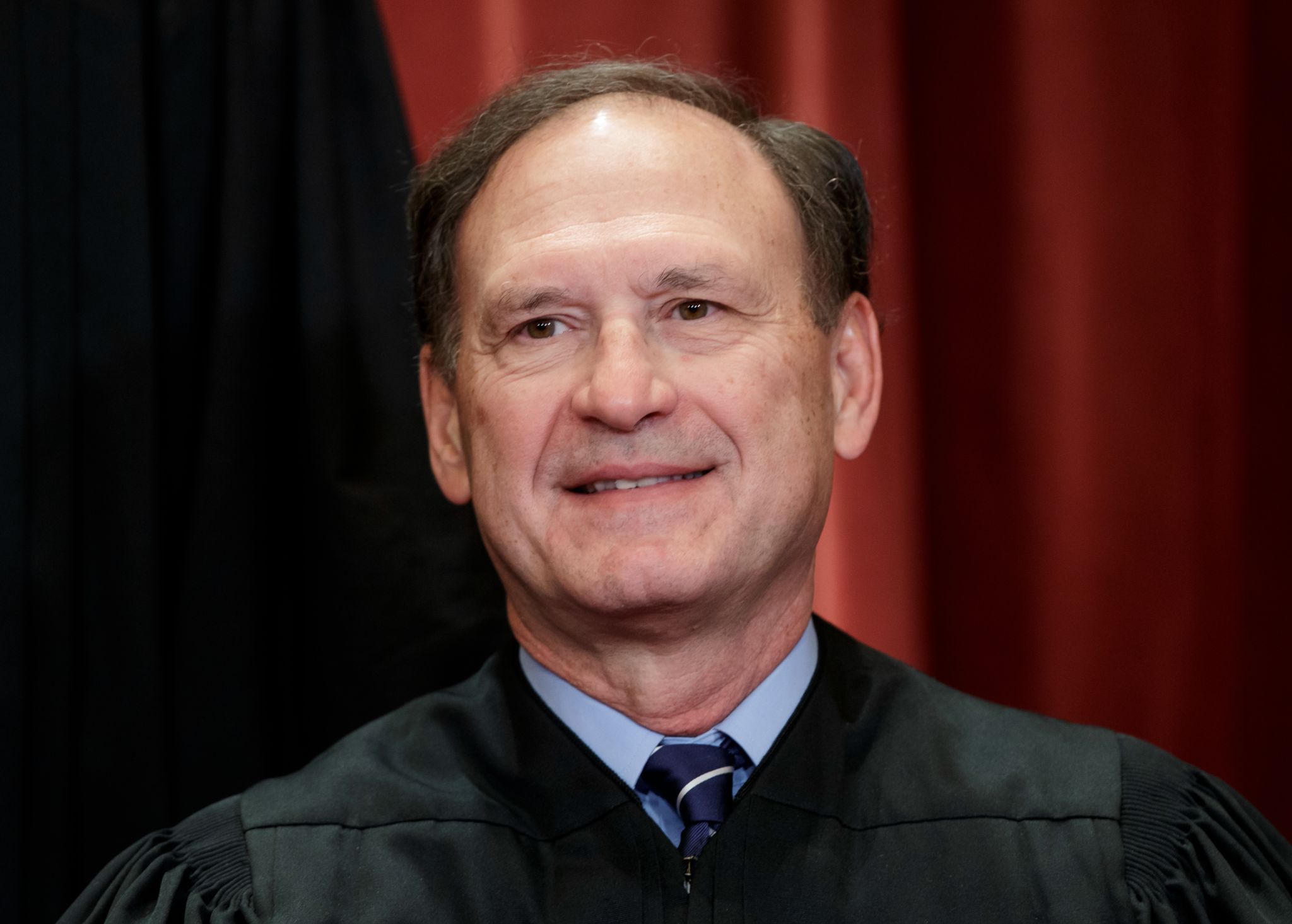The draft is authentic.
It might not be final. It might not be complete. It might have changed and could change some more.
But it is real.
On Monday night, Politico’s Josh Gerstein and Alexander Ward published an explosive story that rocked the Supreme Court and rattled the entire country: “Supreme Court has voted to overturn abortion rights, draft opinion shows.” Mediaite called it the “scoop of the decade.”
As the nation debated the potential ramifications of the Supreme Court possibly overturning Roe v. Wade, the first question that needed to be asked was answered.
Yes, it is a real initial draft of a majority opinion written by Justice Samuel Alito. Chief Justice John Roberts confirmed it on Tuesday. But, he warned, it is not the final decision and he wants an investigation to determine how the draft was leaked.
Roberts said, “To the extent this betrayal of the confidences of the Court was intended to undermine the integrity of our operations, it will not succeed. The work of the Court will not be affected in any way.”
Others will debate and analyze what this might mean for abortion in this country — and I will point out some of that work later in today’s newsletter. But, as a reminder, this is a media newsletter, so the emphasis is going to be on Politico’s scoop and how it obtained the draft and all that entails.
Leaks to media organizations are far from unusual, even on huge stories. But a leaked draft of a Supreme Court decision is practically unheard of. The Washington Post’s Paul Farhi and Jeremy Barr wrote it was a “history-altering bombshell based on something nearly unprecedented in the high court’s modern era.” They added, “While Washington reporters have long relied on leaks from other government officials, the Supreme Court has been a temple of secrecy, the decisions of its nine justices shrouded in mystery until they are formally announced to the public …”
Politico did not give specifics on how it obtained the draft, but in a note to staff, Politico editor-in-chief Matt Kaminski and executive editor Dafna Linzer wrote, in part, “After an extensive review process, we are confident in the authenticity of the draft.”
Then Roberts confirmed the draft on Tuesday.
Again, it’s just a draft (and maybe not even the final one, as I will get to in a bit). As The New York Times’ Jesus Jiménez notes, “The court’s final decision is not expected for another month or more. While overturning Roe v. Wade would constitute a dramatic shift in American politics and law, the draft itself does not have any immediate legal ramifications.”
The reaction
Since Politico’s blockbuster scoop on Tuesday, many conservatives have spent more time talking about the leak of the opinion draft than what’s actually in the draft.
Politico’s Kyle Cheney and Andrew Desiderio wrote, “Few Republican lawmakers were celebrating Tuesday after the disclosure of a Supreme Court draft opinion that would overturn Roe v. Wade. Instead, they were angrily demanding answers to how the document became public in the first place.”
Vice’s Paul Blest was blunter, writing, “So rather than gloat about a win that’s been decades of slowly chipping away at abortion access in the making, the sorest winners in American politics are complaining about the leak of the opinion to Politico.”
Texas Republican Sen. Ted Cruz tweeted that he was “appalled by the shocking breach of trust posed by this leak” and that it was a “blatant attempt to intimidate the Court through public pressure rather than reasoned argument.”
Senate Minority Leader Mitch McConnell (R-Ky.) called the leaked draft “an attack on the independence of the Supreme Court.”
South Carolina Republican Sen. Lindsay Graham said, “I don’t care what your motives were. You did a lot of damage to our country and I don’t know if we can repair this, but we’ll try.” Sen. John Kennedy (R-La.) said, “We have had an unprecedented leak — as despicable as it is dangerous.”
For her 5-Minute Fix newsletter, The Washington Post’s Amber Phillips wrote, “But by focusing on the leak, conservatives are missing the point, liberals argue. The big headline is that the court seems ready to end 50 years of abortion protection in the United States. Their main argument is that a generation of women have grown up believing this protection would be there, and five conservative justices will override that.”
Mind you, we still don’t know where the leak came from. Cheney and Desiderio wrote, “And in the absence of evidence, GOP lawmakers hammered on the unproven assumption that the breach was orchestrated by the left in a bid to intimidate conservative justices to back off their opinion.”
But Glenn Kessler, editor and chief writer of The Washington Post’s Fact Checker, had this interesting tweet: “One can never assume where a leak came from. Maybe it was a liberal. But a WSJ editorial last week suggested real concern Roberts was trying to peel off a vote for a compromise, overturning 5-4 opinion written by Alito. This leak makes compromise harder.”
That April 26 Wall Street Journal editorial said, “But Chief Justice John Roberts tried during the oral argument to find a middle way. He appeared to want to sustain the Mississippi law on grounds that it doesn’t violate Casey’s test of whether there is an ‘undue burden’ on the ability to obtain an abortion. If he pulls another Justice to his side, he could write the plurality opinion that controls in a 6-3 decision. If he can’t, then Justice Thomas would assign the opinion and the vote could be 5-4. Our guess is that Justice Alito would then get the assignment.”
The Journal’s editorial board went on to write, “We hope he doesn’t succeed — for the good of the Court and the country. The Chief’s middle ground might be explainable with some legal dexterity, but it would prolong the Court’s abortion agony. Critics on the left would still lambaste the Court for letting Mississippi’s law stand. And states would soon pass more laws with even narrower restrictions that would eventually force the Justices to overturn Roe and Casey or say the precedents stand on solid ground.
Far better for the Court to leave the thicket of abortion regulation and return the issue to the states. A political uproar would ensue, but then voters would decide on abortion policy through elections — starting in November.”
More about the leak …

Associate Justice Samuel Alito Jr. in November 2018. (AP Photo/J. Scott Applewhite)
Few people cover the Supreme Court as well as New York Times reporter Adam Liptak. His latest piece: “A Supreme Court in Disarray After an Extraordinary Breach.”
Liptak makes this provocative point: “Justice Samuel A. Alito Jr.’s draft opinion is dated Feb. 10, or almost three months ago. Under the court’s ordinary practices, additional drafts have circulated since then, as Justice Alito refined his arguments, made changes to accommodate his allies, responded to criticisms in one or more draft concurrences or dissents — and, crucially, worked to make sure he did not lose his majority.”
Liptak goes on to write, “Still, Justice Alito was no doubt worried that Chief Justice Roberts, who sketched out a middle-ground position at the argument, might threaten his majority. The chief justice suggested that the court could uphold the Mississippi law at issue in the case, which bans abortions after 15 weeks, but stop short of overruling Roe outright.”
And then Liptak mentioned the Wall Street Journal editorial and added, “The point of the leak, then, may have been to lock in the five-justice conservative majority.”
Richard L. Hasen, a law professor at the University of California, Irvine, told Liptak, “I would be wary of jumping to a conclusion that the leaker is necessarily someone who opposes overturning Roe v. Wade.”
Hasen also mentioned this possibility: “It also could be intended to soften the blow by signaling to everyone the earthquake to come.”
Washington Post deputy editorial page editor Ruth Marcus wrote, “Of course, there are other possible culprits: a liberal clerk furious over the loss of abortion rights, perhaps? That makes less sense. Not much would be gained by leaking the draft of an outcome that has been expected since December’s oral argument in the Mississippi case, which involves a ban on most abortions after 15 weeks. Does anybody really think the reaction would change the conservative justices’ minds?”
CNN’s Abby Phillip tweeted about Liptak’s story and wrote, “This story lays out well why the leak itself actually does matter. No one can say with confidence what the final scope of the court’s ruling would have been but the fact of the disclosure absolutely changes things on the court from here on out.”
How rare?
As mentioned, a leaked draft of a Supreme Court opinion is so rare that it had historians and reporters trying to find out if it had ever happened before.
In their Post story, Barr and Farhi wrote, “While Supreme Court leaks are extremely rare, there have been occasional stories that revealed details of the justices’ private deliberations. And the original 1973 Roe decision was leaked to Time magazine by a clerk for Justice Lewis Powell, appearing on newsstands hours before the court announced its decision, which enraged Chief Justice Warren Burger.”
More reaction
- In an opinion piece for The Washington Post, NYU professor Barry Friedman, Slate reporter Dahlia Lithwick and University of Texas School of Law professor Stephen I. Vladeck wrote, “While everyone is busy gasping at the first leak of a draft opinion in modern Supreme Court history — one the chief justice has now confirmed is authentic — it is worth focusing on what brought us here. It is now clear that politics has triumphed over law. All that matters now is who can muster five votes, long-standing precedent (and confirmation hearing commitments to abide by them) be damned.”
- New York magazine’s David Klion wrote, “The one thing the Court apparently can’t control, however, is how much the public knows about its deliberations. The leaker — whoever it is and whatever their motivations — has done a public service, both by giving Americans who support reproductive rights a head start on mobilizing for a post-Roe legal order and by damaging the Court’s mystical aura of legitimacy at precisely the moment when it deserves to be damaged. If the Court is going to function as a partisan institution, then the public should know at least as much about how it works as we know about any other branch of government.”
- On CNN, Massachusetts Democratic Sen. Elizabeth Warren said, “Really? You think the whole issue is about a leak. This is about five extremist justices. … At least two of them swore up and down that they cared about the rule of law and Roe v Wade is settled law.”
- Fox News anchor Sandra Smith seemed a little perturbed about the leak in this interview with Planned Parenthood spokesperson Sam Lau.
And even more coverage

Sen. Susan Collins, R-Maine, arrives for the start of a hearing on Capitol Hill in Washington on Tuesday. (AP Photo/J. Scott Applewhite)
- CNN’s Chris Cillizza with “It looks like Susan Collins bet wrong on Brett Kavanaugh and Roe v. Wade.”
- And, speaking of Collins, Jake Tapper had this on CNN.
- PolitiFact’s Louis Jacobson and Yacob Reyes with “What would state laws look like in a post-Roe world?”
- The New York Times’ Claire Cain Miller and Margot Sanger-Katz with “What Would the End of Roe Mean? Key Questions and Answers.”
- The Atlantic’s Jessica Bruder with “The Future of Abortion in a Post-Roe America.”
- Washington Post columnist Henry Olsen with “The leak is a shock. What the draft decision says is not.”
- The Los Angeles Times’ David G. Savage with “Where Roe went wrong: A sweeping new abortion right built on a shaky legal foundation.”
- CNN with “Watch how Fox News and MSNBC hosts react to Roe v. Wade draft opinion.”
- The New York Times’ Robert Chiarito, Alexandra Glorioso and Ann Hinga Klein with “How Americans are reacting to the Supreme Court news.”
- The Associated Press’ Rebecca Santana, Emily Wagster Pettus and Claire Galofaro with “‘Still in shock.’ Abortion defenders, foes stunned by leak.”
- Politico’s John F. Harris with “Alito Wants a Brawl and Looks Likely to Get One.”
A letter of encouragement, and a warning
Mathias Döpfner — CEO of Politico’s parent company Axel Springer — sent out this memo to Politico’s staff on Tuesday:
Dear POLITICO team,
I have been closely following your conscientious work and its resonance these past few hours. And I wanted to let you know that I admire how you carefully outlined the facts, putting readers’ interest first in a nonpartisan way. The most contentious issues in society are also where our commitment to diligent reporting and editing matters most.
Also, it was a great honor for me to spend the weekend in Washington with some of you. And to experience your enthusiasm about Axel Springer and our mutual future. I truly look forward to bringing POLITICO to the next level together with you all.
Best regards,
Mathias
Meanwhile, New York Times media reporter Katie Robertson tweeted this on Tuesday: “Politico employees have been advised to be vigilant about who enters elevators with them at the office, and to consider removing any personal details from social media accounts that identify them as Politico staff, according to an internal memo.”
The Associated Press’ David Bauder reported Tuesday afternoon, “The company has not reported any specific threats.”
The latest notable journalism from Russia-Ukraine

Firefighters extinguish a fire following a Russian bombardment at a park in Kharkiv, Ukraine, on Tuesday. (AP Photo/Felipe Dana)
While the Politico story about Roe v. Wade dominates the news cycle, let us not forget that a war continues in Ukraine. Check out these stories.
- The New York Times’ Anton Troianovski and Julian E. Barnes with “Russia’s War Has Been Brutal, but Putin Has Shown Some Restraint. Why?”
- From the Pandora Papers, The Washington Post’s Peter Whoriskey with “Three dozen tycoons met Putin on invasion day. Most had moved money abroad.”
- The Los Angeles Times’ Laura King with “‘You can’t postpone living’: Double-amputee war victim’s wedding heartens Ukraine.”
Media tidbits
- ABC News’ Shannon K. Crawford with “Biden meets with parents of American journalist Austin Tice who was abducted in Syria.”
- Francesca Chambers, an eight-year veteran covering the White House, is joining USA Today as a White House correspondent. Chambers goes over from McClatchy, where she also covered the White House.
- Nieman Lab’s Sarah Scire with “The BBC commissions a study to show what life without the BBC would be like.”
- CNN’s Oliver Darcy reports that Rachel Maddow is only hosting the Monday edition of the 9 p.m. Eastern show on MSNBC. What used to be called “The Rachel Maddow Show” is now being called “MSNBC Prime.” Ali Velshi is hosting the rest of this week.
Hot type
- Excellent Wall Street Journal sports columnist Jason Gay writes about the 88-year-old NBA broadcaster and former coach in “Hubie Brown Hasn’t Stopped Coaching.”
- Chris Snow is a former sportswriter — a really good one, I might add — and now an executive for the NHL’s Calgary Flames. He has ALS. The New York Times’ John Branch has the touching story: “Chris Snow Finds That His Luck, Good and Bad, Is All in the Family.”
- On Tuesday, I teased Part 1. Now, today, Vanity Fair’s Evgenia Peretz with “Scene Stealer: The True Lies of Elisabeth Finch, Part 2.”
Have feedback or a tip? Email Poynter senior media writer Tom Jones at tjones@poynter.org.
More resources for journalists
- Subscribe to The Collective — Poynter’s monthly newsletter for journalists of color by journalists of color.
- Hiring? Post jobs on The Media Job Board — Powered by Poynter, Editor & Publisher and America’s Newspapers.
- A Journalist’s Guide to Covering Jails – Memphis (In-person Seminar) July 21-22 — Apply by June 1.
- Teachapalooza: Front-Edge Teaching Tools for College Educators (In-person or Online Seminar) — June 10-12, Apply now.
The Poynter Report is our daily media newsletter. To have it delivered to your inbox Monday-Friday, sign up here.







